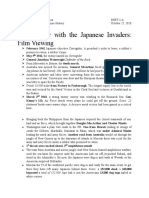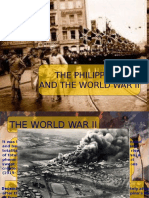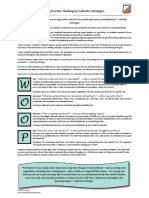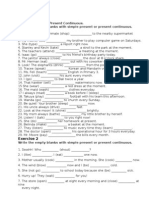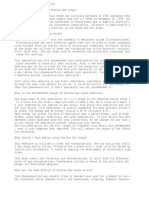0 ratings0% found this document useful (0 votes)
20 viewsRising Sun in The Pearl of The Orient
Rising Sun in The Pearl of The Orient
Uploaded by
Reymond OloganDiscusses the Japanese occupation in the Philippines which occurred between 1942 and 1945 during WWII.
Copyright:
© All Rights Reserved
Available Formats
Download as PDF, TXT or read online from Scribd
Rising Sun in The Pearl of The Orient
Rising Sun in The Pearl of The Orient
Uploaded by
Reymond Ologan0 ratings0% found this document useful (0 votes)
20 views14 pagesDiscusses the Japanese occupation in the Philippines which occurred between 1942 and 1945 during WWII.
Original Title
Rising Sun in the Pearl of the Orient
Copyright
© © All Rights Reserved
Available Formats
PDF, TXT or read online from Scribd
Share this document
Did you find this document useful?
Is this content inappropriate?
Discusses the Japanese occupation in the Philippines which occurred between 1942 and 1945 during WWII.
Copyright:
© All Rights Reserved
Available Formats
Download as PDF, TXT or read online from Scribd
Download as pdf or txt
0 ratings0% found this document useful (0 votes)
20 views14 pagesRising Sun in The Pearl of The Orient
Rising Sun in The Pearl of The Orient
Uploaded by
Reymond OloganDiscusses the Japanese occupation in the Philippines which occurred between 1942 and 1945 during WWII.
Copyright:
© All Rights Reserved
Available Formats
Download as PDF, TXT or read online from Scribd
Download as pdf or txt
You are on page 1of 14
in the Philippines
• On December 7, 1941 (Washington time),
Japanese forces bombed Pearl Harbor in
Hawaii, the main base of the U.S. Pacific Fleet,
resulting to 2,897 deaths.
• General offensive plan: To acquire the Dutch
and British possessions in Southeast Asia.
Japanese navy had to destroy the U.S Pacific
Fleet.
• At the dawn of December 8, 1941 (Philippine
time), 10 hours after the attack in Pearl Harbor,
the Japanese bombers under the command of
General Masaharu Homma, conducted air attacks
in various places of the Philippines.
• The main Japanese forces,
PEARL HARBOR under the command of Lt.
Homma landed
Lingayen, Pangasinan on
in
Dec. 22, 1941.
• They destroyed the air and naval defenses in
Davao, Tuguegarao, Baguio, Iba, Tarlac, and
Clark Field. American planes on the ground
were caught by surprise. The American
Asiatic Fleet in the Philippines withdrew to
Java, Indonesia.
of
and
• December 24, 1941- MacArthur finally implemented War Plan Orange 3 (WPO-
3), which ordered the withdrawal of all island forces to Bataan peninsula and
the evacuation of all civilians within the area
• The enemy bombers were hitting Port Area Manila at the time and President Manuel Quezon
was advised by Gen. MacArthur to evacuate to Corregidor Island.
• December 26, 1941 - General MacArthur declared Manila an open city, wherein the enemy
forces may enter the area provided they stop shooting. This would spare the city from further
destruction. Military installations were removed from Manila.
• On December 30, 1941, the second inaugural ceremonies of the Commonwealth at the
Corregidor tunnel took place. President Quezon took his oath of office as President of the
Commonwealth.
• January 2, 1942 - the Japanese forces had already entered Manila. Many people stayed in air-
raid shelters for many days.
• January 3,1942 - General Masaharu Homma, commander-in-chief of the
Japanese Imperial Forces issued a proclamation announcing the end of the
American occupation and the imposition of martial law in the country.
• January 23, 1942 - Jorge B. Vargas received an order from General
Homma to assume the position of the Executive Commissioner of the
Central Administrative Organization of Occupied Philippines.
• Movement was registered with the imposition of curfew, first from
Martial law 8:00 p.m. to 6:00 a.m., and finally from midnight to 6:00 a.m.,
in the from May 18 onwards.
• When Japanese renewed their offensive on April 3 , 1942 with
of bataan fresh troops, heavy artillery, tanks, and air support, the
and corregidor American and Filipino survivors on the Bataan Peninsula were
so weakened by disease and starvation that they were unable
to offer any effective resistance . The food situation in Bataan
dropped below half-rations .
• Major General Edward King as the commanding officer
Fall of bataan ignored the order of MacArthur and surrendered his troops in
Bataan on April 9, 1942.
• Before the surrender came into effect, he transferred his
female army nurses to Corregidor in the hope that they might
be evacuated from the Philippines. These female nurses were
then considered the “Angels of Bataan”.
• Lieutenant General Wainwright was authorized to continue
the battle against the Japanese to the end following
MacArthur’s order.
• The 11,000 defenders of Corregidor held out against intense
of bataan Japanese bombardment until May 6, 1942. Food, water and
and corregidor ammunition had dropped to critical levels when the Japanese
finally secured a beachhead on the island on May 5, and landed
tanks.
• General Homma warned Wainwright during surrender negotiations
that he would execute all prisoners of war unless the surrender.
• General Wainwright ordered the American flag to be lowered on
Fall of corregidor Corregidor in the hope of avoiding a massacre.
• Defenders of Corregidor were subjected to the same appalling
brutality that had been inflicted by the Japanese on the survivors
of Bataan.
• Nevertheless, the strength and will of the Filipino people did not
waver even after the surrender of Bataan and Corregidor to the
Japanese. Underground guerrilla movements were put into action
by Filipino and American soldiers, as well as unyielding civilians in
the countryside.
• April 10, 1942- Death March began in Mariveles and Cabcaben.
Death march • The Filipino-American troops were forced at gunpoint to march from
Bataan to San Fernando, Pampanga. Some were kicked and beaten.
• Around 10,000 lives were claimed by this infamous trail.
Death march
• On the 4th of July 1942, surrendered Filipino and American
soldiers in Mindanao were made to march on a rocky dirt road
and under the blazing tropical sun, from Camp Keithley in
Dansalan to Iligan in Lanao – a distance of about thirty-six (36)
kilometer (25 miles) prior to their transfer with the rest of the
Mindanao POWs to Camp Casisang, Malaybalay, Bukidnon.
• January 23, 1942 - The Philippine Executive Commission was
established, with Jorge B. Vargas as chairman. The following was
appointed as department heads: Benigno Aquino, Sr., interior; Antonio during the wartime years
de las Alas, finance; Jose P. Laurel, justice; Claro M. Recto, education,
health, and public welfare; and Quintin Paredes, public works and
communication; Jose Yulo was named Chief Justice of the Supreme
court
• December 2,1942 - The Japanese Military Administration announced that political
parties had been dissolved "of their own free will." The Kapisanan sa Paglilingkod sa
Bagong Pilipinas (KALIBAPI), a non-political organization, was established.
• June 18,1943 - the KALIBAPI members appointed a committee to nominate the
members of the Preparatory Commission for Philippine Independence (PCPI).
• The new constitution contained 12 articles lifted from the 1935 constitution that fitted
the wishes of the Japanese.
and the
• September 20, 1943 - The KALIBAPI, under the leadership of its director general,
Benigno Aquino Sr. held a party convention to elect 54 members of the National
Assembly.
• Jose P. Laurel was elected as president of the second republic and both Benigno Aquino
Sr. and Ramon Avancena as a vice-president.
• October 14, 1943 - The new republic was inaugurated on the front steps of the
legislative building in Manila.
• Some farmers of Pampanga banded together and created local brigades for their protection. Luis Taruc, Juan Feleo,
Castro Alejandrino, and other leaders of organized farmers held a meeting in February 1942 in Cabiao, Nueva Ecija.
They agreed to fight the Japanese as a unified guerrilla army
• Representatives from Tarlac, Pampanga and Nueva Ecija threshed out various details regarding their
organization, which they agreed to call "Hukbo ng Bayan Laban sa mga Hapon" or HUKBALAHAP. Taruc was
chosen to be the Leader of the group, with Alejandrino as his right hand man. The members were simply
known as Huks!
• Japanese met stiff resistance by the defensive soldiers as
they attacked the American defensive line on January 9,
and Filipino–American
1942 despite troops living on half-rations, drinking troops
contaminated water, and increasingly weakened by disease.
• Japanese outflanked the defenders of the Abucay-Mauban
Fall of
line by finding an accessible path over Mount Natib. On
January 24, 1942, withdrawal to the island of Corregidor
called the Bagac-Orion line. Despite the hopeful remarks,
no significant support for the defenders would be attained .
MacArthur directed that there would be no more retreats by
his troops on Bataan and no surrender and the troops
resisted every attempt by the Japanese to penetrate their
second line of defense.
• President Roosevelt abandoned the Philippines to the
Japanese.
• US Army Chief of Staff, General George C. Marshall,
contacted MacArthur of an assumed new command in
Fall of
Australia and suggested him to consider leaving the
Philippines.
• On March 11, 1942, MacArthur departed for Australia.
• After landing in Australia on March 17, 1942, Gen.
MacArthur made his promise to the Filipinos. “ ”
• General MacArthur returned to the Philippines with
his army late in 1944.
• From October 23 to October 26, 1944 the Americans
and the Surrender
of the Japanese
engaged Japanese forces in the Battle of Leyte Gulf.
• By mid-December, the American soldiers had reached
Mindoro. US liberation forces successfully docked at
Lingayen Gulf on January 9, 1945
• Lt. Gen. Tomoyuki Yamashita, supreme commander of the Japanese
troops in Manila, mobilize his kamikazes (Japanese suicide pilots);
but they failed to stop Americans. The Japanese also deployed
MAKAPILI units to defend Manila but neither succeeds.
• Fighting continued until Japan's formal surrender on September 2,
1945.
You might also like
- Japanese Occupation in The PhilippinesDocument23 pagesJapanese Occupation in The Philippinesashdetorres80% (5)
- Japanese Occupation: Between 1941 and 1945Document53 pagesJapanese Occupation: Between 1941 and 1945MCDABCNo ratings yet
- Graphic Thinking For Architects & Designers - Maxaw Y.Document258 pagesGraphic Thinking For Architects & Designers - Maxaw Y.Mihai Finaga80% (5)
- Japanese in The PhilippinesDocument15 pagesJapanese in The PhilippineshokforsaleNo ratings yet
- The Philippines and World War IIDocument22 pagesThe Philippines and World War IInoveyNo ratings yet
- Guvan, Geneveb A. (Bsed-Sci 1a) - Japanese PeriodDocument18 pagesGuvan, Geneveb A. (Bsed-Sci 1a) - Japanese PeriodGen GuvanNo ratings yet
- TECSSP Notes On The Japanese PeriodDocument4 pagesTECSSP Notes On The Japanese Periodkenneth0reloxNo ratings yet
- Japanese Occupation: Prepared By: Lee, Hannah Elaine ADocument39 pagesJapanese Occupation: Prepared By: Lee, Hannah Elaine AJohn Marlon SaraNo ratings yet
- PPTDocument22 pagesPPTAnne Marie Angelica Bilono100% (1)
- A Legacy of Heroes: The Story of Bataan and Corregidor: Group 6: Aton, Barnes, Malla, PastoresDocument21 pagesA Legacy of Heroes: The Story of Bataan and Corregidor: Group 6: Aton, Barnes, Malla, PastoresVon Edrick RondaelNo ratings yet
- Bataan Death March HISTORY RESEARCHDocument2 pagesBataan Death March HISTORY RESEARCHJyNo ratings yet
- 3rd++Qtr +Civics+6+Ppt+#1+FinalDocument23 pages3rd++Qtr +Civics+6+Ppt+#1+Finalveidaleighmendoza19No ratings yet
- World War II and Japanese OccupationDocument2 pagesWorld War II and Japanese OccupationSade Louisette ChuaNo ratings yet
- Fall of BataanDocument9 pagesFall of BataanIsabel HigginsNo ratings yet
- Part 6Document11 pagesPart 6Joella Mariel De GuzmanNo ratings yet
- History - Japanese OccupationDocument3 pagesHistory - Japanese OccupationDiane HeartphiliaNo ratings yet
- Bloody War With Japanese InvadersDocument3 pagesBloody War With Japanese InvadersRachelle Danya Dela RosaNo ratings yet
- Mapeh Q2Document4 pagesMapeh Q2Sonny VallejoNo ratings yet
- Japanese Occupation of The PhilippinesDocument46 pagesJapanese Occupation of The PhilippinesCrislynirah Zenitram100% (1)
- Filipino History 01 Japanese InvasionDocument68 pagesFilipino History 01 Japanese InvasionXierre ScarletNo ratings yet
- The Battle Agaisnt The Oppressors - 073412Document27 pagesThe Battle Agaisnt The Oppressors - 073412Jiemalyn Asis Gregorio100% (1)
- Philippines Under The Japanese OccupationDocument5 pagesPhilippines Under The Japanese OccupationJan Keith AbundoNo ratings yet
- Chapter 16Document5 pagesChapter 16paulibutanNo ratings yet
- Japanese Occupation of The PhilippinesDocument5 pagesJapanese Occupation of The PhilippinesAlvin LucernasNo ratings yet
- Social Science 1 - Reviewer For Assignment Quiz No. 3.2Document2 pagesSocial Science 1 - Reviewer For Assignment Quiz No. 3.2Antoine Miguel BorromeoNo ratings yet
- Chapter 13 The Philippine Under The Japanese OccupationDocument24 pagesChapter 13 The Philippine Under The Japanese OccupationApril CaringalNo ratings yet
- Attack On Pearl Harbour: Japanese Occupation and The War YearsDocument3 pagesAttack On Pearl Harbour: Japanese Occupation and The War YearsAilynne Joy Rojas LimNo ratings yet
- Riph - Bataan VS CorregidorDocument1 pageRiph - Bataan VS Corregidoramethys manuelNo ratings yet
- Japanese Occupation - Rape of ManilaDocument2 pagesJapanese Occupation - Rape of ManilaMCDABCNo ratings yet
- Japanese OccupationDocument15 pagesJapanese Occupationkimberlyerl18No ratings yet
- Japanese Occupation (Chapter 9)Document14 pagesJapanese Occupation (Chapter 9)Elvin Vallejos LusayNo ratings yet
- Japanese Occupation Group 5Document21 pagesJapanese Occupation Group 5Marvhory AgacerNo ratings yet
- Bataan Death MarchDocument48 pagesBataan Death MarchJosefantastic 75No ratings yet
- Fall of Bataan: Timeline of Japanese InvasionDocument4 pagesFall of Bataan: Timeline of Japanese InvasionMicah VicenteNo ratings yet
- Japanese HegemonyDocument9 pagesJapanese Hegemonyjanegrace.hernandezNo ratings yet
- The Japanese Oc-WPS OfficeDocument11 pagesThe Japanese Oc-WPS OfficeAira Austria NialaNo ratings yet
- WW2Document3 pagesWW2CAMBNo ratings yet
- 9japanese OccupationDocument29 pages9japanese OccupationJustine May S. ColicoNo ratings yet
- The Japanese RegimentDocument3 pagesThe Japanese RegimentJames Andrew PequeñaNo ratings yet
- MANILA STUDIES - Old Manila - Japanese OccupationDocument9 pagesMANILA STUDIES - Old Manila - Japanese OccupationErlenda ManigaoNo ratings yet
- Synch 5Document42 pagesSynch 5MARK JOEY FILAMONo ratings yet
- Philippines During Japanese OccupationDocument21 pagesPhilippines During Japanese OccupationRoldan Agad SarenNo ratings yet
- Japanese Occupation PeriodDocument16 pagesJapanese Occupation Periodmarissa labatosNo ratings yet
- Japanese Occupation PeriodDocument16 pagesJapanese Occupation Periodmarissa labatosNo ratings yet
- Bataan Death March: Lead-Up To The MarchDocument5 pagesBataan Death March: Lead-Up To The MarchBlaster SilongaNo ratings yet
- Gen. Douglas MacarthurDocument1 pageGen. Douglas Macarthurapoc lordNo ratings yet
- RPHDocument3 pagesRPHHannieNo ratings yet
- Japanese Occupation of The PhilippinesDocument3 pagesJapanese Occupation of The PhilippinesRinchel ObusanNo ratings yet
- Japanese Occupation 1Document7 pagesJapanese Occupation 1Lidelyn Jane CañalitaNo ratings yet
- Japanese Colonial Era in The PhilippinesDocument4 pagesJapanese Colonial Era in The PhilippinesPauline CruzNo ratings yet
- Japanese OccupationDocument5 pagesJapanese OccupationJo RinzNo ratings yet
- The Return ofDocument29 pagesThe Return ofLorjean DucaNo ratings yet
- Philippine History During The Japanese OccupationDocument1 pagePhilippine History During The Japanese OccupationAlyssa QuiambaoNo ratings yet
- Japanese Occupation of The PhilippinesDocument64 pagesJapanese Occupation of The PhilippinesHanz Jose Ilumen33% (3)
- Philippines Campaign (1941-42) : BackgroundDocument3 pagesPhilippines Campaign (1941-42) : BackgroundKrystally DilimNo ratings yet
- DocumentDocument1 pageDocumentgloren abutalNo ratings yet
- Japanese Interregnum HandoutDocument4 pagesJapanese Interregnum HandoutAra DucusinNo ratings yet
- Week 9a - Bataan and CorregidorDocument11 pagesWeek 9a - Bataan and CorregidorToni DulayanNo ratings yet
- Bataan Death MarchDocument2 pagesBataan Death MarchYdnar Christian BaldelovarNo ratings yet
- Maximo Installation Document - Win 7 ProDocument50 pagesMaximo Installation Document - Win 7 ProBhargav EswarNo ratings yet
- 6.5.2 Ch7 HW 1-2 Pert CalcsDocument3 pages6.5.2 Ch7 HW 1-2 Pert CalcswilchaNo ratings yet
- Meaning and Use: Although, Even Though, Despite, in Spite Of, However and ButDocument2 pagesMeaning and Use: Although, Even Though, Despite, in Spite Of, However and ButTeona TegadzeNo ratings yet
- Brief Facts:: Inditex vs. Oriental Cuisines PVT LTDDocument3 pagesBrief Facts:: Inditex vs. Oriental Cuisines PVT LTDEsha PandeyNo ratings yet
- Bpi Vs TarampiDocument2 pagesBpi Vs TarampiInnah Agito-RamosNo ratings yet
- Kufr Bit Taghut SimpleDocument7 pagesKufr Bit Taghut SimpleSadiya SwalehNo ratings yet
- ItemsDocument16 pagesItemsDjeedozeNo ratings yet
- Mitd Dentsu Koichi PresentationDocument51 pagesMitd Dentsu Koichi Presentationdp4mobNo ratings yet
- Function 2 - Paper 2Document4 pagesFunction 2 - Paper 2Bramantya PribadiNo ratings yet
- Code of Conduct History 1Document3 pagesCode of Conduct History 1Jm MotoNo ratings yet
- Emp News (Eng)Document24 pagesEmp News (Eng)JP EDSNo ratings yet
- Ma BohemeDocument198 pagesMa BohemeJohn ValenteNo ratings yet
- RULE 103 Change of Name Section 1. Venue.Document3 pagesRULE 103 Change of Name Section 1. Venue.Anonymous wDganZNo ratings yet
- Insights From Rethinking Positive Thinking by Gabriele OettingenDocument1 pageInsights From Rethinking Positive Thinking by Gabriele OettingenChritian Laurenze LauronNo ratings yet
- OB Chapter 3Document62 pagesOB Chapter 3let it beNo ratings yet
- In Re: Robbyn Dale Mattson and Renee Diane Mattson, 9th Cir. BAP (2012)Document22 pagesIn Re: Robbyn Dale Mattson and Renee Diane Mattson, 9th Cir. BAP (2012)Scribd Government DocsNo ratings yet
- Printable 2024 Calendars Cats LandscapeDocument12 pagesPrintable 2024 Calendars Cats LandscapeDeby ViardiantyNo ratings yet
- Simple Present or Present Continuos Exercise 1 and 2Document2 pagesSimple Present or Present Continuos Exercise 1 and 2Veronica Tandra100% (10)
- Devi Mahatmyam Devi Kavacham in EnglishDocument5 pagesDevi Mahatmyam Devi Kavacham in Englishrk100% (1)
- AMS - Fall Western Sectional Meeting, AMS Special SessionsDocument7 pagesAMS - Fall Western Sectional Meeting, AMS Special SessionsmqtrinhNo ratings yet
- Nicene CreedDocument5 pagesNicene CreedTu IoNo ratings yet
- Commercial Law Lecture 07-05-2019 PDFDocument12 pagesCommercial Law Lecture 07-05-2019 PDFเจียนคาร์โล การ์เซียNo ratings yet
- STR - Manvi-26 - Bba 3Document59 pagesSTR - Manvi-26 - Bba 355 Tanya MathpalNo ratings yet
- OfloxacinDocument3 pagesOfloxacinAnandUnniNo ratings yet
- Total Quality Management Frameworks: A Comparative Analysis in Construction CompaniesDocument6 pagesTotal Quality Management Frameworks: A Comparative Analysis in Construction CompaniesInternational Journal of Innovative Science and Research TechnologyNo ratings yet
- Study of Developmental Stages of A MosquitoDocument13 pagesStudy of Developmental Stages of A MosquitoMahendranath Ramakrishnan53% (17)
- Metabolomics 2012 Module1Document104 pagesMetabolomics 2012 Module1Nathan PittmanNo ratings yet
- GoenkasDocument154 pagesGoenkasMridul SPL VolvoNo ratings yet
- Persia, India, & China Research EssayDocument6 pagesPersia, India, & China Research EssayLauren LawsonNo ratings yet
















